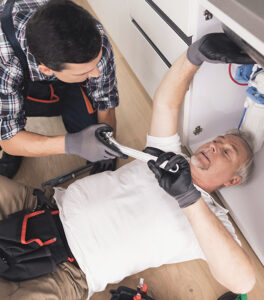Dishwashers have become an essential appliance in many households, making our lives easier by taking care of the tedious task of washing dishes. However, like any other electrical appliance, dishwashers can experience issues from time to time. One of the most common areas where problems can arise is with the dishwasher’s electrical and control board components.
The electrical and control board components of a dishwasher work together to ensure the proper functioning of the appliance. The control board is responsible for receiving and interpreting signals from the user interface, sensors, and other components, and then sending commands to various parts of the dishwasher to carry out the desired functions. The electrical components, such as switches, fuses, and timers, provide the necessary power and control for these commands to be executed.
Key Takeaways
- Dishwasher electrical and control board issues can prevent the appliance from starting or functioning properly.
- Common causes of dishwasher failure to start include power supply issues, faulty door switches, and blown thermal fuses.
- Checking the power supply to the dishwasher involves verifying that the outlet and circuit breaker are working correctly.
- Testing the dishwasher door switch requires using a multimeter to check for continuity.
- Inspecting the dishwasher thermal fuse involves locating the component and checking for continuity with a multimeter.
Common Causes of Dishwasher Failure to Start
One of the most frustrating issues that can occur with a dishwasher is when it fails to start. There are several common reasons why this may happen. The first thing to check is whether the dishwasher is receiving power. This can be done by checking if the dishwasher is plugged in properly and if there is power supply to the outlet.
If the power supply is not the issue, then it could be a problem with the door switch. The door switch is a safety feature that prevents the dishwasher from starting if the door is not securely closed. If the door switch is faulty or not making proper contact, it can prevent the dishwasher from starting.
Another common cause of a dishwasher failing to start is a blown thermal fuse. The thermal fuse is designed to protect the dishwasher from overheating by cutting off power if it detects excessive heat. If the thermal fuse blows, it will need to be replaced before the dishwasher can start again.
Checking the Power Supply to the Dishwasher
To check if the dishwasher is receiving power, start by ensuring that it is plugged in properly. Sometimes, the plug can become loose or disconnected, causing the dishwasher to lose power. If the plug is securely connected, check if there is power supply to the outlet by plugging in another appliance or using a voltage tester.
If there is power supply to the outlet, but the dishwasher still does not start, it could be an issue with the circuit breaker or fuse. Check the circuit breaker panel or fuse box and look for any tripped breakers or blown fuses. If you find any, reset the breaker or replace the fuse and try starting the dishwasher again.
If there is no power supply to the outlet, it could be a problem with the electrical wiring. In this case, it is best to call a professional electrician to inspect and repair any wiring issues.
Testing the Dishwasher Door Switch
The door switch is a safety feature that prevents the dishwasher from starting if the door is not securely closed. To test the door switch, start by unplugging the dishwasher and removing the inner door panel. Locate the door switch and use a multimeter to test for continuity.
Set the multimeter to the continuity or resistance setting and touch one probe to each terminal of the door switch. If there is no continuity or resistance reading, it means that the door switch is faulty and needs to be replaced.
If the door switch is functioning properly, check if it is making proper contact with the door latch. Sometimes, dirt or debris can prevent the switch from making a secure connection. Clean any dirt or debris from the switch and latch and try starting the dishwasher again.
Inspecting the Dishwasher Thermal Fuse
The thermal fuse is a safety device that cuts off power to the dishwasher if it detects excessive heat. To inspect and test the thermal fuse, start by unplugging the dishwasher and locating the thermal fuse, which is usually located on or near the control board.
Use a multimeter to test the thermal fuse for continuity. Set the multimeter to the continuity or resistance setting and touch one probe to each terminal of the thermal fuse. If there is no continuity or resistance reading, it means that the thermal fuse has blown and needs to be replaced.
If the thermal fuse is intact, check for any signs of overheating or damage. If the fuse appears to be damaged or melted, it is a sign of a larger issue and may require professional repair.
Examining the Dishwasher Control Board

The control board is responsible for receiving and interpreting signals from the user interface, sensors, and other components, and then sending commands to various parts of the dishwasher. If there are issues with the control board, it can cause the dishwasher to fail to start or function properly.
To examine the control board, start by unplugging the dishwasher and removing the inner door panel. Locate the control board, which is usually located at the top of the door or behind the user interface. Inspect the control board for any signs of damage, such as burnt or melted components.
If there are no visible signs of damage, check for loose connections or corroded terminals. Sometimes, a loose connection or corrosion can cause issues with the control board. Clean any corrosion and tighten any loose connections. If there are still issues with the control board, it may need to be replaced.
Troubleshooting the Dishwasher Timer or Electronic Control
The dishwasher timer or electronic control is responsible for controlling the various cycles and functions of the dishwasher. If there are issues with these components, it can cause the dishwasher to fail to start or function properly.
To troubleshoot the dishwasher timer or electronic control, start by unplugging the dishwasher and removing the inner door panel. Locate the timer or electronic control, which is usually located near the control board.
Inspect these components for any signs of damage, such as burnt or melted components. If there are no visible signs of damage, check for loose connections or corroded terminals. Clean any corrosion and tighten any loose connections. If there are still issues with the timer or electronic control, it may need to be replaced.
Replacing Faulty Dishwasher Components
If any of the dishwasher components, such as the door switch, thermal fuse, control board, or timer/electronic control, are found to be faulty and cannot be repaired, they will need to be replaced.
To replace these components, start by unplugging the dishwasher and removing the inner door panel. Locate the faulty component and disconnect any wires or connectors attached to it. Remove the component from its mounting and replace it with a new one.
When replacing components, it is important to use genuine manufacturer parts to ensure compatibility and proper functioning of the dishwasher. Follow the manufacturer’s instructions for installation and reassemble the dishwasher.
Preventing Future Dishwasher Electrical and Control Board Issues
To prevent future dishwasher electrical and control board issues, it is important to practice regular maintenance and care for the appliance. Here are some tips to help prevent these issues:
1. Clean the dishwasher regularly: Remove any food debris or residue from the dishwasher after each use. This will prevent clogs and buildup that can cause electrical issues.
2. Check and clean the filters: Most dishwashers have filters that need to be cleaned regularly. Check your dishwasher’s manual for instructions on how to clean the filters.
3. Avoid overloading the dishwasher: Overloading the dishwasher can put strain on the electrical components and cause them to fail. Follow the manufacturer’s guidelines for loading capacity.
4. Use proper detergent: Using the wrong detergent can cause excessive sudsing, which can lead to electrical issues. Use a detergent specifically designed for dishwashers.
5. Avoid using excessive heat: Using excessive heat settings can put strain on the thermal fuse and other components. Use the appropriate heat settings for your dishes.
When to Call a Professional for Dishwasher Repair
While many dishwasher electrical and control board issues can be resolved with basic troubleshooting and replacement of faulty components, there are times when it is necessary to call a professional for repair.
If you are unsure about how to troubleshoot or replace dishwasher components, it is best to call a professional. They have the knowledge and experience to diagnose and repair complex electrical issues.
When choosing a dishwasher repair service, look for a reliable and experienced company. Check online reviews and ask for recommendations from friends or family. Make sure the company is licensed and insured, and inquire about their warranty or guarantee on repairs.
In conclusion, dishwasher electrical and control board issues can be frustrating, but with proper troubleshooting and maintenance, many issues can be resolved. By following the steps outlined in this article, you can identify and resolve common issues that may prevent your dishwasher from starting or functioning properly. Remember to always prioritize safety when working with electrical components and consult a professional if you are unsure or uncomfortable with any aspect of the repair process.
If you’re experiencing issues with your dishwasher not starting, it could be due to electrical or control board problems. To help diagnose and troubleshoot these issues, check out this informative article on Dishwasher Won’t Start: Diagnosing Electrical and Control Board Issues. It provides valuable insights and tips to get your dishwasher up and running again. For more appliance repair services and information, visit https://911Appliance.com/our-blog/.
Can Electrical and Control Board Issues Cause a Dishwasher to Run Continuously?
Yes, fixing dishwasher control issues is crucial as it can cause a dishwasher to run continuously. Electrical and control board problems can lead to malfunctioning cycles, leading to the dishwasher running non-stop. Proper diagnosis and repair of these issues are necessary to prevent continuous running and potential damage to the appliance.



